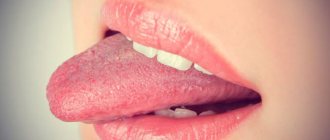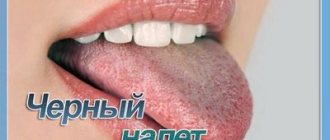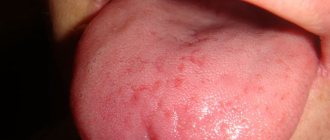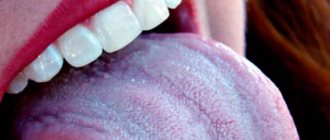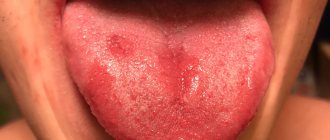.
For parents, children and their health are the most important thing. Every mother begins to panic when she sees the sad state of the child, the pale appearance of the face, the color of the tongue is different than before. The baby's tongue is very sensitive to the external environment. Its mucous membrane always reacts to taste factors, allergies, antibacteriosis and other phenomena. From this it can acquire a plaque. Based on its color, the doctor diagnoses possible diseases. Where does a child’s brown tongue come from and how can it threaten a child’s health?
Brown tongue in children may be a sign of a serious illness
What is plaque on the tissues of the tongue?
We will divide the reasons for the formation of layering into groups:
- anatomical;
- hygienic:
- medicinal.
The tongue as an anatomical organ of a person is unique in that its mucous membrane is covered with an epithelial cover with formations in the form of papillae. They help us taste food. They are also easily susceptible to the destructive effects of microbes and bacteria. Therefore, epithelial cells become obsolete, peel off, replacing themselves with young cells. But it happens that this process is inhibited by the upper layers of the epithelial membrane, which, during the active change of cells, die, but do not crumble, forming a coating on the tongue.
The cause of plaque is the use of strong antibiotics
Types of plaque
A similar phenomenon happens to everyone: both children and adults. We don’t even think about healthy plaque and don’t pay attention to it. It appears more or less depending on the time of year. In the summer, when the period of berries, fruits, and vegetables begins, the layer on the tongue is quite noticeable, since it has different shades:
- white;
- yellow;
- green;
- even dark blue.
In winter, plaque is not visible on a healthy body.
Yellow coating on the tongue occurs due to liver diseases
Why does plaque appear on the tissues of the tongue?
The appearance of dense plaque is often a symptom of a disease in the body. As soon as you notice that your tongue has become coated with a layer of distinctive color, you should be careful.
Thick plaque will indicate chronic diseases and complex infections.
Therefore, it is important to identify the cause of its formation in time. Especially when it comes to the health of the child.
Medical terminology
In medical practice, the following types of plaque stains are distinguished:
- diffuse,
- local.
A diffuse appearance occurs when the entire surface of the tongue is covered with a colored layer. The local type involves the formation of plaque on a specific area of the mucous membrane.
Diffuse plaque covers the entire tongue
In addition, the accumulation can have a different structure: be wet or dry, have a curd-like shape. Soft plaque can be quickly removed by scraping off with a toothbrush or a special scraper. A hard scraper is more dangerous and requires medical intervention.
How does plaque appear on a child’s tongue?
A brown coating on a child’s tongue occurs due to insufficient oral hygiene. It seems that infants cannot have such a problem, because they have no teeth and nothing to brush, but they also need to clean their mouth after breastfeeding. Kids learn to explore the world, so they taste everything, in this way they introduce different microorganisms to themselves.
Medications also provoke the appearance of a bacterial layer.
A newborn in the outside world is not protected from diseases and infections. In especially difficult cases, mothers have to turn to medicinal treatments. As a result, the child may develop an allergy to drugs, pathogenic microflora in the mouth, which reveals itself with a coated tongue.
Brown coating on the tongue in children
In childhood, deposits on a muscle organ can be diagnosed for various reasons.
- For example, dental problems. In such a situation, dental treatment should be entrusted to an experienced dentist.
- However, the tongue becomes covered with accumulations as a result of consuming coloring products, especially those with chemical additives. In infants, this often happens from the introduction of new complementary foods. Therefore, if your tongue turns from soft pink to brown, change your diet.
- A slight brown coating on a child’s tongue is also observed during ARVI. Hygiene and quality nutrition will help get rid of this unpleasant phenomenon.
- Schoolchildren may suffer from congestion due to bronchitis and incipient pneumonia, as well as gastrointestinal problems.
In any situation, parents should show their child to a pediatrician. If necessary, the baby is referred to a gastroenterologist, endocrinologist, infectious disease specialist and other specialists. After examination and diagnosis, adequate therapy is prescribed.
Causes of brown plaque
Most often, a newborn's tongue becomes white or yellow. In the first case, it acquires color due to the formation of thrush, but quickly renews and passes. In the second case, the baby may have problems with the liver, which results in jaundice.
Brown plaque is less common and seems to be a more dangerous phenomenon for the child’s health, especially if it appears on the tongue of an infant.
Brown plaque in teenagers is due to hormonal changes
Doctors name the following reasons for a brown tongue:
- Disturbance of gastrointestinal processes, digestive problems.
- A state of dehydration resulting from elevated temperature or low fluid levels in the body.
- Lack of B vitamins.
- Ingestion of fats, food poisoning.
- Reaction to certain medications.
Coca-Cola turns your tongue brown
There is another reason that is not related to the biological nature of the body. This reason is somewhat banal, but it is not uncommon - eating brown foods:
- chocolate;
- caramels;
- soda;
- dark berries, etc.
A change in the appearance of the tongue occurs during the reaction of dyes with the mucous membrane. After all, parents are not always able to control their children’s consumption of foods with dyes. Buckwheat porridge can also leave a dark tint.
Shades of brown plaque
Due to problems with the digestion of the body, the tongue can acquire a brown color of different shades: light brown, yellow-brown and dark brown. When diagnosing a child, the doctor asks to show the tongue and by the shade he can find out the type of disease and its cause.
Layer light brown
A light brown color of the tongue will indicate a problem with the respiratory tract or lymph inflammation.
Digestive problems are the cause of yellow-brown plaque
Layer yellow-brown
The causes of yellow-brown plaque are more related to diseases of the stomach and intestines. The main reasons include:
- Inflammatory processes of the duodenum.
- Cases of bile entering the gastric tract.
- Cases of hepatitis.
- Prolonged dehydration due to vomiting or diarrhea.
A dark brown layer on the epithelium of the mucous membrane indicates that the child may have problems with the kidneys, liver, and gall bladder.
Tooth decay in children can cause plaque on the tongue
If you notice the appearance of a layer of brown plaque in any shade on your baby’s tongue, it is better to immediately consult a doctor.
Plaque for the little ones
A brown coating on a baby's tongue is a cause of concern, as this is not typical for him. The first and main reason for this phenomenon will be the introduction of complementary foods into food, when the mother’s milk is no longer sufficient. Taking complementary foods is not an easy process for a newborn’s body. He still can't get used to the new nutrients. Brown plaque is the baby’s body’s reaction to supplements.
A newborn's coated tongue may indicate bowel problems and even a lung problem.
But in such cases, mothers should pay attention to the child’s temperature. If a child has a fever and at the same time there is a brown coating on the tongue, it is necessary to call an ambulance in order to provide qualified assistance in a timely manner.
A yellow coating appears in infants with the start of complementary feeding
Examination of a child in the clinic
Self-medication by parents can end in failure. For proper consultation, you should contact your pediatrician, who will determine the cause and method of preventing infection.
It is important to consider the location of plaque on the tongue in newborns. If the accumulation is visible at the tip, this may indicate a problem with the functioning of the lungs, and may be a sign of bronchial disease. If the layering does not disappear within 2-3 days, this may be a manifestation of an infectious disease such as scarlet fever or influenza. In the form of symmetrical spots, it is a symptom of incipient pneumonia. A brown layer in the center of the tongue is a clear sign of a gastrointestinal disease. In the specialized literature, the concept of “geographical” language is found - this is when plaque spots are localized along the surface in different parts. This kind of coating may indicate infection of the baby’s body with worms.
A consultation with a dentist will help identify the cause of the plaque.
Diagnosis of the disease
In a hospital examination, an accurate diagnosis is established after a general and biochemical blood test, an antibody test, a scraping from the mucous membrane of the tongue, and a urine and stool test. Other studies may be needed: ultrasound of the stomach and intestines, respiratory tract, fiberoscopy and gastroscopy, etc.
Chocolate stained tongue
Depending on the detected test results, parents should consult a doctor: gastroenterologist, toxicologist, infectious disease specialist. If a child’s baby teeth begin to erupt or are already clearly visible, then you should definitely show them to the dentist; sometimes the reason is that the baby has carious teeth.
How is diagnosis carried out?
An accurate diagnosis is established only after a series of the following medical examinations:
- General blood analysis;
- Blood biochemistry;
- Antibody test;
- Scraping from the surface of the tongue;
- Stool and urine analysis.
In some cases , an ultrasound examination of the stomach, intestines or respiratory tract may be required .
Need to know! Depending on the results found, the pediatrician may give a referral to other doctors: a gastroenterologist, an infectious disease specialist, a toxicologist, or a dentist.
Prevention of brown plaque on the tongue
We have already found out the reasons for the appearance of a brown coating on a child’s tongue. But how can you prevent this symptom? Rules should be followed to prevent all kinds of diseases associated with changes in the color structure of the tongue. These rules are stated by doctors all over the world, and they are also often voiced by the famous doctor Komarovsky. The rules are simple, but must be followed systematically:
- The room where there is a child must always be clean and tidy; the room should be ventilated, the air humidified.
- At the first appearance of a brown plaque, the mother should call a doctor rather than try to cure the symptom on her own (whether using medication or grandma’s folk remedies).
Oral hygiene - prevention of plaque formation
You need to constantly monitor your baby's condition. If you notice a plaque, think about what the child has been given to eat recently, what he has taken, how he is doing with the toilet, and whether he has a fever. If you notice a connection with foods, try reducing the dose for a couple of days or completely removing it from your diet. Then check to see if the natural color of the tongue has returned. The main thing is to establish in time the tendency towards darkening and thickening of the plaque layer.
If your child already indulges in sweets, limit the amount of colored foods: candy, marmalade, soda. All this food has a destructive effect on the child’s body, including the epithelium of the tongue.
Causes of brown plaque on the tongue
So, the appearance of masses on a muscle organ of an unnatural color is an alarming symptom. There are different reasons for the appearance of brown plaque. Moreover, they can be both serious and superficial, which can be easily eliminated.
- Excessive consumption of chocolate and coffee leaves its mark. True, this problem is easily solved; such a layering does not pose a threat. It is enough to balance the coloring product and clean your mouth regularly.
- Such deposits are typical for people who are addicted to alcoholic beverages and cigarettes. Inhalation of resins not only forms plaque, but also the appearance of stones on the crowns, which causes dental caries.
- The appearance of the film is also provoked by such serious factors as lung disease, joint inflammation, blood disease, problems with the adrenal glands and the endocrine system.
And the list of reasons goes on.
In the morning
To correctly determine the provoking aspect of an unpleasant phenomenon, you should pay attention to the time at which it appears. Normally, in the morning, a light and transparent film may be present on the muscle organ. After hygiene procedures it disappears. Dark deposits are a sign of problems in the body. They are constantly detected, after cleaning they disappear for a short time and appear again.
If the sticky masses are intensely colored in the morning, it is possible that the digestive system or airways are not functioning properly. In the first case, the deposits are located on the back wall of the tongue, and in the second - on the tip. If the accumulations do not even partially disappear after cleaning or eating, you should suspect chronic diseases. Remember, the presence of deposits for three days or more requires a visit to the doctor so as not to miss the intoxication of the body.
Stomatitis
Light brown plaque may indicate progressive stomatitis.
- Initially the deposits are white. But, if the patient ignores the therapy, the film acquires a brownish tint.
- The mucous membranes of the mouth are painful, especially when removing accumulations.
- Ulcers form in the mouth and tongue. Discomfort increases when the disease is advanced.
Gastrointestinal diseases
A dark brown coating on the tongue most often indicates problems with the gastrointestinal tract. This is the reaction of the receptor system to the presence of pathology of the intestines or stomach, pancreas or gall bladder.
- Fibrous or corrosive gastritis.
- Inflammation of the small intestine (enterocolitis) or large intestine.
- Ulcerative diseases.
- Dysbacteriosis or reflux.
- Pancreatitis or diarrhea.
- Hepatitis or cholecystitis.
- Duodenitis or biliary dyskinesia.
In such cases, treatment of the underlying disease and comprehensive cleaning of the oral cavity are needed. If treatment is carried out in a timely manner, complications are excluded.
Fungal diseases
A very common provoking factor for deposits on the muscular organ is progressive oral candidiasis. When the mucous membranes are affected by mycosis (fungus), at an early stage the film has a whitish color. It is difficult to remove. If left untreated, the lesions begin to darken. In advanced stages, erosive foci form, which are located in the central part of the muscular organ. A white-brown coating obliges the patient to immediately visit a doctor. Only he can establish the true cause of the disease and develop a treatment program.
Taking antibiotics and other medications
Taking certain medications also causes brown deposits on the tongue.
- Such side effects are often diagnosed after antibiotics. The accumulations may disappear on their own when the therapeutic course ends.
- It happens that deposits are a consequence of drug abuse.
- The color of the muscular organ often changes after taking pharyngosept.
- A brown tongue provokes malavit.
Before starting therapy, be sure to read the instructions. If this is a side effect of the medication, the problem will go away after a course of therapy.
B vitamin deficiency and weakened immunity
Another cause of dark deposits is hypovitaminosis, which leads to a decline in the immune system. Lack of vitamins PP and B, as well as iron, negatively affects oral health. Sometimes a disease such as pellagra occurs, which is caused by a deficiency of nicotinic acid. Vitamin deficiency causes both a gray-brown coating and the appearance of painful cracks and a “varnished” tongue. Regardless of the reason, careful oral hygiene is mandatory. The tongue is cleaned daily with a special toothbrush.
How to treat brown plaque?
It is difficult to talk about the treatment of brown plaque, since it is not a separate disease, but only a symptom. No doctor will recommend any medications or procedures to cure a coated tongue. It is not the symptom that needs to be treated, but the disease.
The main diseases that manifest themselves with similar indicators include:
- Gastritis.
- Stomach ulcer.
- Infection.
- Weakened immunity.
- Oral diseases.
Only a specialist doctor can make a correct diagnosis and prescribe appropriate treatment. It will identify high-quality antibiotics. It happens that he prescribes a topical medication such as tretinoin. After the course of treatment, the appearance of brown color on the tongue will disappear.
The drug Tretionin is prescribed by a doctor for treatment
Possible treatment
Treatment of brown plaque involves eliminating the root cause , since it is not a separate disease, but only a symptom of the underlying disease.
Only a doctor can make a correct diagnosis and prescribe treatment.
In most cases, he prescribes antibiotics and medications to regulate the functioning of the gastrointestinal tract .
If the course of treatment is successful, the brown plaque disappears on its own.




